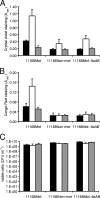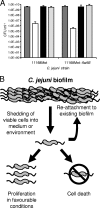Biofilm formation by Campylobacter jejuni is increased under aerobic conditions
- PMID: 20139307
- PMCID: PMC2849235
- DOI: 10.1128/AEM.01878-09
Biofilm formation by Campylobacter jejuni is increased under aerobic conditions
Abstract
The microaerophilic human pathogen Campylobacter jejuni is the leading cause of food-borne bacterial gastroenteritis in the developed world. During transmission through the food chain and the environment, the organism must survive stressful environmental conditions, particularly high oxygen levels. Biofilm formation has been suggested to play a role in the environmental survival of this organism. In this work we show that C. jejuni NCTC 11168 biofilms developed more rapidly under environmental and food-chain-relevant aerobic conditions (20% O(2)) than under microaerobic conditions (5% O(2), 10% CO(2)), although final levels of biofilms were comparable after 3 days. Staining of biofilms with Congo red gave results similar to those obtained with the commonly used crystal violet staining. The level of biofilm formation by nonmotile aflagellate strains was lower than that observed for the motile flagellated strain but nonetheless increased under aerobic conditions, suggesting the presence of flagellum-dependent and flagellum-independent mechanisms of biofilm formation in C. jejuni. Moreover, preformed biofilms shed high numbers of viable C. jejuni cells into the culture supernatant independently of the oxygen concentration, suggesting a continuous passive release of cells into the medium rather than a condition-specific active mechanism of dispersal. We conclude that under aerobic or stressful conditions, C. jejuni adapts to a biofilm lifestyle, allowing survival under detrimental conditions, and that such a biofilm can function as a reservoir of viable planktonic cells. The increased level of biofilm formation under aerobic conditions is likely to be an adaptation contributing to the zoonotic lifestyle of C. jejuni.
Figures




Similar articles
-
The influence of dissolved oxygen level and medium on biofilm formation by Campylobacter jejuni.Food Microbiol. 2017 Feb;61:120-125. doi: 10.1016/j.fm.2016.09.008. Epub 2016 Sep 12. Food Microbiol. 2017. PMID: 27697161
-
Tetrazolium reduction allows assessment of biofilm formation by Campylobacter jejuni in a food matrix model.J Appl Microbiol. 2013 Nov;115(5):1212-21. doi: 10.1111/jam.12316. Epub 2013 Aug 20. J Appl Microbiol. 2013. PMID: 23910098
-
Flagella-mediated adhesion and extracellular DNA release contribute to biofilm formation and stress tolerance of Campylobacter jejuni.PLoS One. 2014 Aug 28;9(8):e106063. doi: 10.1371/journal.pone.0106063. eCollection 2014. PLoS One. 2014. PMID: 25166748 Free PMC article.
-
Does Campylobacter jejuni form biofilms in food-related environments?Appl Environ Microbiol. 2014 Sep;80(17):5154-60. doi: 10.1128/AEM.01493-14. Epub 2014 Jun 13. Appl Environ Microbiol. 2014. PMID: 24928882 Free PMC article. Review.
-
Mechanistic concepts involved in biofilm associated processes of Campylobacter jejuni: persistence and inhibition in poultry environments.Poult Sci. 2024 Dec;103(12):104328. doi: 10.1016/j.psj.2024.104328. Epub 2024 Sep 12. Poult Sci. 2024. PMID: 39366290 Free PMC article. Review.
Cited by
-
Virulence and Genomic Feature of Multidrug Resistant Campylobacter jejuni Isolated from Broiler Chicken.Front Microbiol. 2016 Oct 14;7:1605. doi: 10.3389/fmicb.2016.01605. eCollection 2016. Front Microbiol. 2016. PMID: 27790202 Free PMC article.
-
How a sugary bug gets through the day: recent developments in understanding fundamental processes impacting Campylobacter jejuni pathogenesis.Gut Microbes. 2012 Mar-Apr;3(2):135-44. doi: 10.4161/gmic.19488. Epub 2012 Mar 1. Gut Microbes. 2012. PMID: 22555465 Free PMC article. Review.
-
Enhanced Biofilm Formation by Ferrous and Ferric Iron Through Oxidative Stress in Campylobacter jejuni.Front Microbiol. 2018 Jun 6;9:1204. doi: 10.3389/fmicb.2018.01204. eCollection 2018. Front Microbiol. 2018. PMID: 29928267 Free PMC article.
-
Enhanced transmission of antibiotic resistance in Campylobacter jejuni biofilms by natural transformation.Antimicrob Agents Chemother. 2014 Dec;58(12):7573-5. doi: 10.1128/AAC.04066-14. Epub 2014 Sep 29. Antimicrob Agents Chemother. 2014. PMID: 25267685 Free PMC article.
-
Exploring the potential environmental functions of viable but non-culturable bacteria.World J Microbiol Biotechnol. 2013 Dec;29(12):2213-8. doi: 10.1007/s11274-013-1390-5. Epub 2013 Jun 4. World J Microbiol Biotechnol. 2013. PMID: 23733177 Review.
References
-
- Achen, M., T. Y. Morishita, and E. C. Ley. 1998. Shedding and colonization of Campylobacter jejuni in broilers from day-of-hatch to slaughter age. Avian Dis. 42:732-737. - PubMed
-
- Asakura, H., M. Yamasaki, S. Yamamoto, and S. Igimi. 2007. Deletion of peb4 gene impairs cell adhesion and biofilm formation in Campylobacter jejuni. FEMS Microbiol. Lett. 275:278-285. - PubMed
-
- Barken, K. B., S. J. Pamp, L. Yang, M. Gjermansen, J. J. Bertrand, M. Klausen, M. Givskov, C. B. Whitchurch, J. N. Engel, and T. Tolker-Nielsen. 2008. Roles of type IV pili, flagellum-mediated motility and extracellular DNA in the formation of mature multicellular structures in Pseudomonas aeruginosa biofilms. Environ. Microbiol. 10:2331-2343. - PubMed
-
- Black, R. E., M. M. Levine, M. L. Clements, T. P. Hughes, and M. J. Blaser. 1988. Experimental Campylobacter jejuni infection in humans. J. Infect. Dis. 157:472-479. - PubMed
Publication types
MeSH terms
Substances
Grants and funding
LinkOut - more resources
Full Text Sources
Other Literature Sources
Molecular Biology Databases

